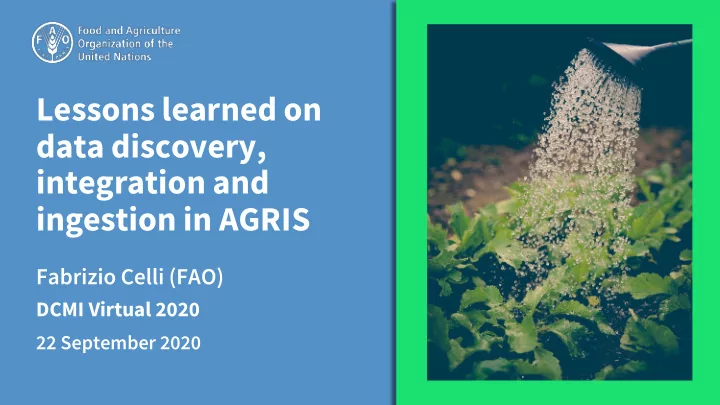

Lessons learned on data discovery, integration and ingestion in AGRIS Fabrizio Celli (FAO) DCMI Virtual 2020 22 September 2020
FAO The Food and Agriculture Organization (FAO) is a specialized agency of the United Nations that leads international efforts to defeat hunger and improve nutrition and food security It was founded in October 1945 The FAO is headquartered in Rome, Italy and maintains regional and field offices around the world, operating in over 130 countries 2
AGRIS Initiative set up by FAO in 1974 to make information on agriculture research globally available . A collection of multilingual bibliographic metadata on agricultural research A network of nearly 450 data providers from 150 countries https://agris.fao.org 3
The AGRIS Network 4
AGRIS Data Providers Originally, AGRIS centers were assigned by governments to collect all the scientific production in the country and to send it to AGRIS From 2005, AGRIS accepts data also from institutional repositories, journal publishers and aggregators With the evolution of technology and the growth of open access institutional repositories , AGRIS has improved its methods for harvesting, processing and indexing metadata 5
Challenges Challenges Integration of new data in AGRIS ● Variety of metadata formats ● Variety of standards Different levels of metadata quality ● Automatic ingestion from web APIs ● Understand the relevance of high-volume data (data discovery) ● Content classification and data integration 6
AGRIS Metadata Formats AGRIS accepts the most common XML metadata formats such as MODS, Crossref, DOAJ, EndNote, MARC21, METS, Simple DC, PubMed and AGRIS AP The data is curated and converted prior to the AGRIS indexing The AGRIS team highly recommends to consider LODE-BD Recommendations 2.0 in order to learn about different metadata terms that can be used to describe properties included in the record 7
Initial phase: manual validation Data Collection Journal National Institutional Aggregators Publishers Libraries Repositories Metadata validation Data Processing Data Publication 8
Data Processing Data Collection Data Processing 1 2 Metadata validation Conversion to Data Cleaning and mapping AGRIS AP 3 Metadata Conversion to Enrichment 4 AGRIS RDF Data Publication 9
Automatic harvesting and integration In the digital era, many institutions and organizations expose the data on the web Big volumes of data from heterogenous sources raise problems of relevance, data classification, data standardization, data validation, and data provenance Data relevance and data classification require new solutions 10
AGROVOC Controlled vocabulary covering all areas of interest of FAO, translated into 39 languages Curated and multilingual list of related contents It can help with data discovery and classification 11
Facing with data relevance The problem of data relevance refers to the ability of harvesting only data that belong to the AGRIS domain Data is not always classified, or the classification is very often poor The AGRIS solution: machine learning using data already available in AGRIS and the richness of AGROVOC 12
Facing with data classification AGRIS relies on AGROVOC to enable multilingual search and to connect the data (internally and to external data) Being able to classify and tag metadata with AGROVOC is important to enrich the semantics of AGRIS content The AGRIS solution: machine learning using AGROVOC and natural language processing techniques 13
Thank you! AGRIS@fao.org http://agris.fao.org 14
Recommend
More recommend